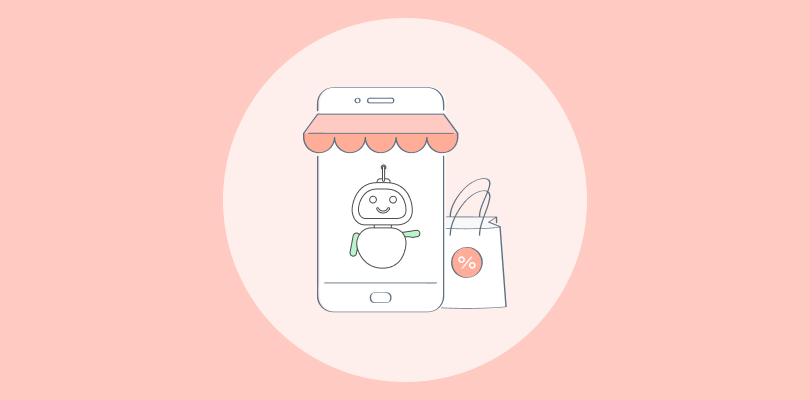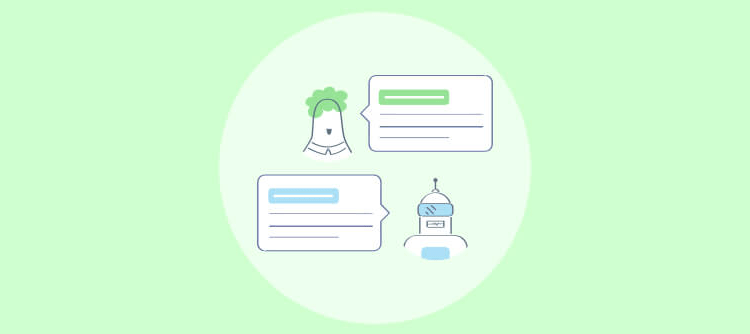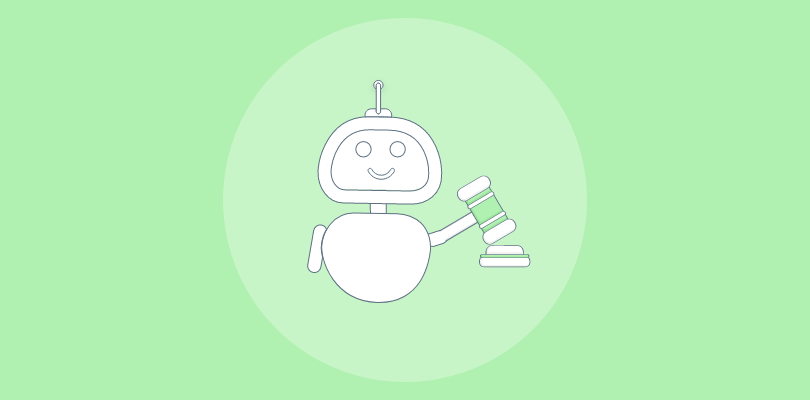Did you know that by 2028, the global chatbot market is expected to reach a whopping $15.5 billion? Yes, you read that right!
Whether it’s for instant support, smarter sales, or unforgettable customer interactions, AI chatbots aren’t just improving the customer journey — but they’re entirely transforming it!
Big brands are already harnessing chatbots’ power to deliver seamless, personalized experiences. This growing adoption is a clear sign that AI chatbots are here to stay, which is why we’re exploring some of the best AI chatbot examples today.
So, get ready to discover 18 groundbreaking real-world chatbot examples that set new customer experience standards.
Let’s get started!
What makes a Good Chatbot?
A good chatbot can transform user interactions and make customer service more efficient. Here are key qualities that make a chatbot stand out:
Provide 24/7 Automated Customer Support
One of the most powerful features of a good chatbot is its ability to provide round-the-clock customer support. It can answer common queries, troubleshoot issues, and offer immediate assistance—ensuring your customers always feel supported, no matter the time of day.

This automation not only reduces the workload of human agents but also enhances customer satisfaction by providing quick responses.
Data-Driven Training
For a chatbot to handle a wide variety of inquiries, it must be trained with AI using your company’s existing knowledge base, FAQs, product details, and website data. This allows the chatbot to provide contextually accurate and detailed responses.

By using structured data, such as articles, product pages, or documentation, the chatbot becomes a powerful resource for answering detailed questions and providing support across different use cases.
Boost Sales & Capture More Leads
A good chatbot should be designed to engage visitors effectively, capturing potential leads through personalized conversations. By asking the right questions and guiding users through a sales funnel, chatbots can qualify leads, schedule demos, and even make product recommendations. Integrating with your CRM and marketing tools, chatbots help nurture leads and increase conversion rates.
Simple Setup & Easy Configuration
A great chatbot should be simple to set up, even for non-technical users. With an intuitive interface and easy-to-follow setup instructions, businesses can quickly deploy a chatbot without needing coding knowledge.
The ability to integrate with various platforms and tools, along with the option to test your bot before deployment, makes it even easier for businesses to get up and running.
Fully Customizable to Fit Your Brand
Customization is key to creating a chatbot that aligns with your brand’s tone and needs. A good chatbot platform allows you to adjust its appearance, language, and responses, ensuring it reflects your unique style.

Whether it’s customizing the greeting, creating dynamic workflows, or incorporating personalized messages based on user behavior, the flexibility to tailor the chatbot helps improve user experience and brand consistency.
18 Best Chatbot Examples Revolutionizing Different Sectors
AI chatbots are reshaping customer interactions, making them faster, more efficient, and personalized. Below are some best chatbot examples from big brands that showcase how AI is revolutionizing customer service and driving business success.
Chatbot Examples of Customer Support
1. ProProfs Chat
ProProfs Chat is an exceptional AI chatbot platform designed to streamline customer interactions. One of its standout features is its ability to train chatbot with AI using your existing knowledge base to deliver accurate, automated responses. You can deploy your chatbot to handle a wide range of tasks like lead generation, appointment scheduling, and customer support.
Also, ProProfs Chat supports real-time visitor tracking and multi-channel communication and can integrate with other tools like CRM systems. With an intuitive interface, ProProfs Chat can be customized to match your brand’s voice. It’s a powerful, flexible solution for businesses of all sizes.
Features:
- Canned responses
- Transfer of conversation from a chatbot to a human when necessary.
- Real-time language translation
Benefits:
- Automate customer support 24×7
- User-friendly and easy to set up
- Engage with customers in 70+ languages
Effects:
- ProProfs Chatbot helped Raynor Garage Doors boost their efficiency, enabling them to seamlessly support 700+ dealerships.
- With its automated lead capture and qualification features, ProProfs Chatbot has led to a 30% increase in qualified leads, driving higher conversion rates.
2. Drift
Salesloft Drift goes beyond basic rule-based bots by using AI to understand and respond to visitor inquiries in a personalized way. This allows Drift to engage with potential customers more naturally, provide relevant information, and qualify leads in real-time.

Drift’s AI capabilities also extend to other areas like email communication. It can analyze buyer activity and suggest relevant email content, making sales outreach more efficient and effective. By automating tasks and providing valuable insights, Drift helps businesses improve their sales process and create a better experience for potential customers.
Features:
- GPT suggested replies
- Multilingual support
- AI engagement scoring
Benefits:
- Converts website visitors into leads with personalized, intent-driven messaging
- Offers pre-built templates and fast onboarding
- Connects with tools like Salesforce for smooth workflows
Effects:
- Drift’s AI-driven conversations have resulted in a 30% boost in pipeline growth, creating more revenue opportunities.
- Drift’s AI-powered chat has doubled the conversion rate from MQL to SQL, improving lead qualification efficiency.
3. IBM Watsonx Assistant
IBM Watsonx Assistant is a powerful AI chatbot that allows businesses to build conversational interfaces for various applications. It leverages natural language understanding (NLU) to interpret user requests and provide accurate and relevant responses. This allows for more engaging and human-like interactions, improving customer satisfaction.

Beyond basic interactions, Watsonx Assistant can be integrated with other systems and databases. This allows it to access and process information to perform tasks like booking appointments, providing personalized recommendations, and even answering complex questions, making it a valuable tool for businesses across industries.
Features:
- Intent recognition
- Integration with other systems
- Multi-channel deployment
Benefits:
- Easily tailor workflows to fit specific business needs
- Simplifies deployment with minimal technical expertise required
- Engages customers seamlessly across chat, voice, and messaging platforms
Effects:
- IBM Watson Assistant helps companies save up to $5.50 per conversation, totaling more than $13 million in savings over three years due to improved automation.
- With a 4.7/5 rating from over 1,000 users, Watsonx Assistant is recognized for its advanced AI capabilities and seamless integration.
Chatbot Examples of eCommerce
4. H&M’s Kik Chatbot
H&M’s Kik chatbot is a great example of how AI can be used to create a more personalized shopping experience. It interacts with users conversationally, asking questions about their style to provide tailored outfit recommendations. This approach makes online shopping more engaging and mimics the experience of having a personal stylist.

The chatbot also incorporates visual elements by presenting users with images of clothing items and outfits. This helps users visualize the suggestions and make quicker decisions. By leveraging AI and a conversational approach, H&M aims to create a more personalized and enjoyable shopping experience for its customers on the Kik platform.
Features
- Provides images for easy visualization
- Suggests outfits based on your preferences
- Helps you find specific items
Benefits:
- Boosts brand interaction through conversation
- Offers curated options for quicker buying
- Attracts younger audiences with a trendy experience
Effects:
- The chatbot reached an impressive 86% engagement rate, with users spending an average of four minutes interacting with it, showing strong customer involvement.
- H&M’s chatbot outperformed its email marketing efforts, achieving an 8% click-through rate compared to the typical 2% from email campaigns, highlighting its effectiveness in driving action.
5. Sephora Virtual Assistant
Sephora’s Virtual Assistant uses natural language processing (NLP) to understand customer inquiries and provide personalized recommendations on products, tutorials, and even booking appointments. This creates a seamless and engaging experience for beauty enthusiasts.

Beyond basic questions, the Virtual Assistant can analyze skin tones through photos and recommend suitable makeup shades. This innovative feature bridges the gap between online and in-store experiences, allowing customers to experiment virtually with makeup before purchasing. Sephora’s Virtual Assistant demonstrates how AI can enhance customer interaction and personalize the beauty shopping journey.
Features:
- Personalized product recommendations
- Shade matching
- Booking appointments
Benefits:
- Helps customers find the right products without browsing endlessly
- Allows users to try before they buy, reducing purchase anxiety
- Offers a seamless and engaging way to interact with the brand
Effects:
- Sephora’s Virtual Artist has been used for over 50 million virtual try-ons, showing strong customer engagement.
- Users engaging with the Virtual Artist feature are converting at a rate 2.5 times higher than non-users.
6. Levi’s Virtual Stylist
Levi’s Virtual Stylist acts as a personalized assistant, guiding customers through the process of finding the perfect pair of jeans. By asking questions about style preferences and fit, it offers tailored recommendations, mimicking the in-store experience with a knowledgeable sales associate.

The chatbot goes beyond basic algorithms by incorporating the expertise of Levi’s stylists. It considers factors like leg shape, rise, and stretch to provide accurate suggestions. This helps customers navigate the vast array of options and find jeans that fit their needs and preferences, ultimately increasing satisfaction and reducing returns.
Features:
- Personalized fit recommendations
- Detailed product information
- Size guidance
Benefits:
- Quickly narrows down options to find the perfect pair
- Helps you choose the right fit and style the first time
- Provides a personalized and efficient shopping journey
Effects:
- Levi’s Virtual Stylist improves the online shopping experience by providing personalized recommendations based on individual style preferences.
- The chatbot has contributed to better conversion rates by assisting customers in finding the perfect fit and reducing purchase hesitation.
Chatbot Examples of Healthcare
7. Buoy Health
Buoy Health’s AI chatbot offers a symptom checker that uses a conversational approach to help users understand their health concerns. By asking a series of questions about symptoms and medical history, it provides personalized information and potential diagnoses, guiding users towards appropriate care.

What sets Buoy apart is its vast medical knowledge base and sophisticated AI algorithms. It draws on thousands of clinical papers and real patient data to offer accurate and relevant information. This helps users make informed decisions about their health and navigate the often complex healthcare system with more confidence.
Features:
- AI-powered symptom checker
- Clinician-written content
- Editorial standards ensure quality information
Benefits
- Understand your health issues and find the right care
- Find the right product/service/doctor for you
- Provides reliable health information at your fingertips
Effects
- Over 91% of Buoy Health users are successfully guided to the right care.
- Assisted over 9 million users and saved 29,000+ healthcare professional hours during the COVID-19 pandemic.
8. Ada Health
Ada Health utilizes a sophisticated AI engine to understand user symptoms and provide personalized health assessments. By asking a series of questions, it helps users identify potential causes for their concerns and offers relevant information and guidance.

Ada’s AI goes beyond simple symptom checking by considering various factors like medical history, lifestyle, and risk factors. This allows for a more comprehensive and accurate assessment. It also provides personalized recommendations, which may include self-care advice, further investigation, or seeking medical attention, empowering users to take control of their health.
Features:
- Access to health articles and resources
- Symptom tracking
- Medication reminders
Benefits:
- Expands your knowledge and understanding of health issues
- Provides valuable information to share with your healthcare provider
- Empowers you to take control of your health and manage your conditions effectively
Effects:
- Ada Health has powered over 29 million symptom assessments, enabling users worldwide to access personalized health insights.
- Ada’s AI integration helps healthcare providers make timely, accurate clinical decisions.
9. Babylon Health
Babylon Health is a pioneer in using AI to make healthcare more accessible. Its chatbot acts as a virtual health assistant, allowing users to check symptoms, get health information, and even book appointments with doctors. This makes it easier for people to manage their health and navigate the healthcare system.

One of Babylon’s key features is its ability to provide personalized advice. By analyzing user data and symptoms, it offers tailored recommendations and helps users understand potential health issues. This can empower individuals to take control of their well-being and make informed decisions about their care.
Features:
- Doctor consultations
- Prescription renewals
- Health monitoring
Benefits:
- Offers a cost-effective alternative to traditional doctor visits
- Helps you identify potential health issues quickly
- Makes healthcare more convenient and accessible
Effects:
- Babylon’s AI chatbot provides consultations with 80% accuracy, handling common health queries effectively.
- The chatbot has significantly boosted patient engagement by offering 24/7 healthcare support.
Chatbot Examples of Travel and Hospitality
10. Booking.com Chatbot
Booking.com’s AI chatbot assists users in finding and booking hotels, flights, and other accommodations. The chatbot leverages natural language processing (NLP) to understand customer queries and provide accurate, real-time responses, making it easy for travelers to get assistance anytime.

Key features of Booking.com’s chatbot include multi-language support, which allows it to cater to a global audience, and personalized recommendations based on user preferences and past behavior. The bot integrates with Booking.com’s database, providing real-time details on availability, prices, and amenities through the chat. This improves both user experience and operational efficiency.
Features:
- Booking management
- Personalized recommendations
- Multilingual support
Benefits:
- Avoids waiting on hold for customer service
- Easily manage your bookings and get travel information
- Provides a seamless and personalized travel planning experience
Effects:
- Booking.com’s chatbot can manage 60% of all customer requests automatically in under a minute.
- By automating responses, Booking.com has been able to improve operational efficiency, reducing the need for human intervention.
11. KLM Royal Dutch Airlines – BlueBot
KLM Royal Dutch Airlines introduced BlueBot (BB), an AI-powered chatbot designed to help customers with booking flights and other services via messaging platforms like Facebook Messenger. This self-learning bot engages users in a conversational style, providing personalized and friendly assistance.

While BlueBot can handle many inquiries independently, it can also refer customers to human agents if needed, ensuring continuous, smooth support. BlueBot operates across multiple digital channels, providing assistance in nine languages, including English, French, and Spanish.
Features:
- Real-time flight status updates and details
- Booking assistance
- Check-in and boarding
Benefits:
- Manage your flights and travel arrangements with ease
- Get instant answers to your travel questions and concerns
- Receive quick and efficient support from KLM
Effects:
- BlueBot manages 16,000+ inquiries per week, streamlining customer support and reducing agent workload.
- More than 50% of customer inquiries are now handled by BlueBot, allowing human agents to focus on complex issues.
12. Marriott International Chatbot
Marriott International has leveraged AI technology to improve its guest experience and streamline operations. Its chatbot offers real-time assistance, helping guests with booking, reservations, and personalized recommendations based on preferences and past interactions. This ensures a more tailored and efficient service, improving customer satisfaction and encouraging repeat visits.

Besides personalized service, Marriott employs AI for operational efficiency. Predictive analytics help optimize staffing and inventory management, while automated revenue management algorithms determine pricing strategies based on market trends and guest behavior. These tools boost performance and keep Marriott competitive with data-driven decision-making.
Features:
- Round-the-clock customer service
- Personalized recommendations
- Voice integration
Benefits:
- Guests can easily access information or make requests from anywhere, anytime
- Quick, automated responses save time for both guests and staff
- Helps Marriott streamline operations and optimize resources like staffing and inventory management
Effects:
- Marriott’s chatbot achieved a 97% response rate, earning Facebook’s “Very Responsive” badge for efficiently handling customer queries
- Integrated with platforms like Facebook Messenger and Slack, Marriott’s chatbot streamlines bookings and inquiries, enhancing the guest experience
Chatbot Examples of Education
13. Duolingo Bot
Duolingo Bot stands out as a highly effective AI chatbot example, particularly for language learning. It uses natural language processing (NLP) to create conversational exercises that mimic real-life interactions. Users can engage in interactive lessons, receive instant feedback, and improve their speaking and listening skills through real-time conversations.

Duolingo Bot provides personalized interactions, offering tailored challenges based on a user’s progress. Additionally, it maintains a fun and gamified experience with instant feedback, keeping learners motivated and helping them steadily advance through various stages of language proficiency.
Features:
- Personalized lessons
- Gamified experience
- Instant feedback
Benefits:
- Offers a dynamic and interactive way to learn a new language
- Learners can practice speaking and listening without fear of judgment
- Users can learn anytime, anywhere, fitting language practice into their busy schedules
Effects:
- Duolingo boasts over 500 million users globally, with its chatbot feature playing a key role in maintaining high engagement and learner retention.
- The Duolingo app has a rating of 4.7 stars on both the App Store and Google Play, showcasing strong user satisfaction with the chatbot’s interactive language lessons.
14. Atlas Chatbot by Stanford University
Atlas, the AI chatbot developed by Stanford University, is an impressive example of how advanced AI can improve human-computer interaction. Known for its cutting-edge conversational abilities, Atlas is powered by deep learning models that enable it to process and respond to complex queries with remarkable accuracy.

Atlas excels in contextual understanding, delivering precise and relevant responses that are thoughtfully tailored to the user’s intent. It also supports multi-turn conversations, enabling users to engage in in-depth discussions seamlessly.
Features:
- Advanced contextual understanding
- Integration capabilities
- AI-Powered learning
Benefits:
- Delivers personalized and precise responses
- Learn from interactions to deliver smarter solutions over time
- Resolves queries efficiently, saving time for users
Effects:
- Atlas has successfully assisted thousands of users, providing accurate, real-time responses that enhance learning and research.
- The chatbot streamlines processes at Stanford University by handling complex queries, allowing students and faculty to access information faster.
15. Coursera Coach by Coursera
Coursera Coach is an AI-powered chatbot designed to enhance the online learning experience for Coursera users. It provides personalized guidance, helping students navigate through their courses by answering questions, suggesting resources, and offering tips for better learning.

Coursera Coach allows you to track student progress and provide tailored recommendations based on performance. It can also integrate with course content to offer timely assistance on assignments, quizzes, and exams. Coursera Coach enhances retention and satisfaction by offering personalized support throughout the learning journey.
Features:
- Personalized feedback
- Assessment preparation
- Concept clarification
Benefits:
- Encourages active learning by offering real-time support
- Helps students stay on track with personalized guidance
- Instant answers to questions save time, allowing for more focused study
Effects:
- Coursera Coach has helped thousands of students improve their course completion rates through personalized guidance and real-time support.
- The chatbot’s tailored recommendations have increased user engagement, making learning more interactive and enjoyable for Coursera users.
Chatbot Examples of Finance
16. Erica by Bank of America
Erica, the AI chatbot by Bank of America, offers an innovative and user-friendly way to interact with banking services. Erica provides customers with instant support for a wide range of banking needs, from checking account balances to making transactions. The chatbot is designed to guide users through various financial tasks, making banking easier and more efficient.

It also offers personalized financial insights, helping users manage their spending and savings. With its integration into the Bank of America mobile app, Erica provides seamless access to banking services and delivers a highly convenient, 24/7 support experience.
Features:
- Personalized financial insights
- Transaction assistance
- Spending analysis
Benefits:
- Provides instant, on-demand help without waiting for a representative
- Assists users in tracking and managing their finances more effectively
- Delivers insights that cater to individual financial habits
Effects:
- Erica has successfully assisted over 10 million customers, providing personalized financial guidance and support through voice and text interactions.
- Erica helps users complete over 3 million tasks monthly, from bill payments to transaction tracking, enhancing overall banking convenience.
17. Eva by HDFC Bank
Eva, the AI chatbot by HDFC Bank, is an innovative tool designed to enhance customer service with its intelligent, responsive capabilities. Eva can understand and process customer queries in real-time, providing instant support. Its ability to handle a wide range of banking-related questions makes it an invaluable asset for both customers and the bank.

Due to its 24/7 availability, Eva ensures customers can get assistance anytime, without any delays. It also integrates seamlessly with HDFC Bank’s systems, allowing it to provide accurate account information, process transactions, and answer specific inquiries.
Features:
- Provides details on HDFC Bank’s products and services
- Real-time query resolution
- Locates nearby branches and ATMs
Benefits:
- Avoid waiting in lines or on hold for customer service
- Ensures immediate assistance without waiting
- Works across platforms, including the HDFC website and mobile app
Effects:
- Eva handles over 10 million customer interactions monthly, showcasing its popularity and effectiveness in providing seamless support.
- Eva resolves more than 80% of customer queries without human intervention, significantly improving service efficiency.
18. AmEx Virtual Assistant by American Express
The AmEx Virtual Assistant by American Express provides instant support for a variety of tasks, from answering billing inquiries to helping with account management. With its advanced natural language processing capabilities, the chatbot understands and responds to customer queries in a conversational manner, ensuring a smooth and intuitive interaction.

AmEx Virtual Assistant seamlessly integrates with American Express’ systems, providing real-time transaction details, balance updates, and even fraud alerts. Additionally, it offers personalized recommendations based on user preferences, helping customers manage their finances more effectively.
Features:
- Real-time transaction details
- Fraud alerts to notify users of any suspicious activity
- Rewards information
Benefits:
- Manage your account anytime, anywhere
- Get instant answers to common questions and complete tasks efficiently
- Reduces the need for human intervention, allowing faster query resolution
Effects:
- The AmEx Virtual Assistant has achieved a 4.7/5 rating, with over 5 million interactions monthly, demonstrating its effectiveness in resolving customer queries.
- The assistant handles more than 30% of customer service inquiries, reducing wait times and improving overall customer experience.
Drive Sales and Boost Customer Satisfaction with the Best AI Chatbot!
AI chatbots are transforming the way big brands engage with their customers, offering smarter, faster, and more efficient solutions. From enhancing customer support to driving sales, these conversational chatbot examples prove the power of AI in business today.
Want to level up your customer interactions? ProProfs Chat brings you an intuitive, customizable chatbot that handles everything from lead generation to support automation.
With powerful AI features such as visitor tracking, and canned responses, it’s the perfect choice to take your customer experience to the next level.
Learn More About AI Chatbot Examples: FAQs
Which industries use chatbots the most?
The industries that use chatbots the most include e-commerce, customer service, healthcare, banking, education, and travel. They boost customer support, streamline transactions, and improve user experiences across these sectors.
How do chatbots improve customer service?
Chatbots improve customer service by providing instant responses, reducing wait times, and ensuring 24/7 availability. They can handle multiple queries simultaneously, allowing human agents to focus on more complex issues. By automating routine tasks like FAQs and basic troubleshooting, chatbots enhance efficiency and improve overall customer satisfaction
What technology is used to create chatbots?
Chatbots are created using a combination of natural language processing (NLP), machine learning (ML), and artificial intelligence (AI) technologies. These technologies help chatbots understand user input, learn from interactions, and generate relevant responses.
 Tips
Tips
We’d love to hear your tips & suggestions on this article!
FREE. All Features. FOREVER!
Try our Forever FREE account with all premium features!


 We'd love your feedback!
We'd love your feedback! Thanks for your feedback!
Thanks for your feedback!







